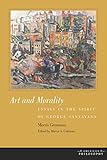Art and Morality : Essays in the Spirit of George Santayana / Morris Grossman, Martin A. Coleman.
Material type: TextSeries: American PhilosophyPublisher: New York, NY : Fordham University Press, [2014]Copyright date: ©2014Description: 1 online resource (336 p.)Content type:
TextSeries: American PhilosophyPublisher: New York, NY : Fordham University Press, [2014]Copyright date: ©2014Description: 1 online resource (336 p.)Content type: - 9780823257232
- 9780823257959
- 700.1 23
- N72.E8 .G76 2014eb
- online - DeGruyter
| Item type | Current library | Call number | URL | Status | Notes | Barcode | |
|---|---|---|---|---|---|---|---|
 eBook
eBook
|
Biblioteca "Angelicum" Pont. Univ. S.Tommaso d'Aquino Nuvola online | online - DeGruyter (Browse shelf(Opens below)) | Online access | Not for loan (Accesso limitato) | Accesso per gli utenti autorizzati / Access for authorized users | (dgr)9780823257959 |
Browsing Biblioteca "Angelicum" Pont. Univ. S.Tommaso d'Aquino shelves, Shelving location: Nuvola online Close shelf browser (Hides shelf browser)

|

|

|

|

|

|

|
||
| online - DeGruyter Eddic, Skaldic, and Beyond : Poetic Variety in Medieval Iceland and Norway / | online - DeGruyter At Freedom's Limit : Islam and the Postcolonial Predicament / | online - DeGruyter Freedom and Limits / | online - DeGruyter Art and Morality : Essays in the Spirit of George Santayana / | online - DeGruyter Italoamericana : The Literature of the Great Migration, 1880-1943 / | online - DeGruyter Sabato Rodia's Towers in Watts : Art, Migrations, Development / | online - DeGruyter Even in Chaos : Education in Times of Emergency / |
Frontmatter -- Contents -- Acknowledgments -- Editor’s Preface -- Introduction -- Part One. Art and Morality -- One. Art and Morality -- Two. Morality Bound and Unbound -- Three. Music, Modulation, and Metaphor -- Four. Performance and Obligation -- Five. A Mozartian Recognition Scene -- Six. A Note on Economy and Art -- Seven. An Aesthetic Glance at the Constitution -- Eight. Human Rights and Artistic Appreciations -- Part Two. Artistic Philosophers and Philosophical Artists -- Nine. Interpreting Peirce -- Ten. On Ruf’s The Creation of Chaos: William James and the Stylistic Making of a Disorderly World -- Eleven. How Sartre Must Be Read -- Twelve. On Beardsley’s “An Aesthetic Definition of Art” -- Thirteen. Lessing as Philosophical Dramatist -- Fourteen. Lewis Carroll -- Fifteen. Art and Death -- Sixteen. Brancusi -- Part Three. Santayana -- Seventeen. Drama and Dialectic -- Eighteen. Ontology and Morality -- Nineteen. Spirited Spirituality -- Twenty. Interpreting Interpretations -- Twenty- One. Santayana’s Aesthetics -- Twenty- Two. Santayana’s The Last Puritan -- Twenty- Three. Santayana in California -- Twenty- Four. Ultimate Santayana -- Notes -- Index
restricted access online access with authorization star
http://purl.org/coar/access_right/c_16ec
The guiding theme of these essays by aesthetician, musician, and Santayana scholar Morris Grossman is the importance of preserving the tension between what can be unified and what is disorganized, random, and miscellaneous. Grossman described this as the tension between art and morality: Art arrests a sense of change and yields moments of unguarded enjoyment and peace; but soon, shifting circumstances compel evaluation, decision, and action. According to Grossman, the best art preserves the tension between the aesthetic consummation of experience and the press of morality understood as the business of navigating conflicts, making choices, and meeting needs.This concern was intimately related to his reading of George Santayana. The best philosophy, like the best art, preserves the tension between what can be ordered and what resists assimilation, and Grossman read Santayana as exemplifying this virtue in his embrace of multiple perspectives. Other scholars have noted the multiplicity or irony in Santayana’s work, but Grossman was unique in taking such a style to be a substantive part of Santayana’s philosophizing.
Mode of access: Internet via World Wide Web.
In English.
Description based on online resource; title from PDF title page (publisher's Web site, viewed 03. Jan 2023)


